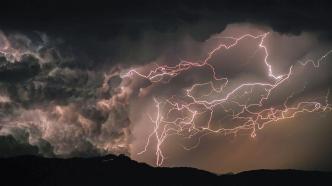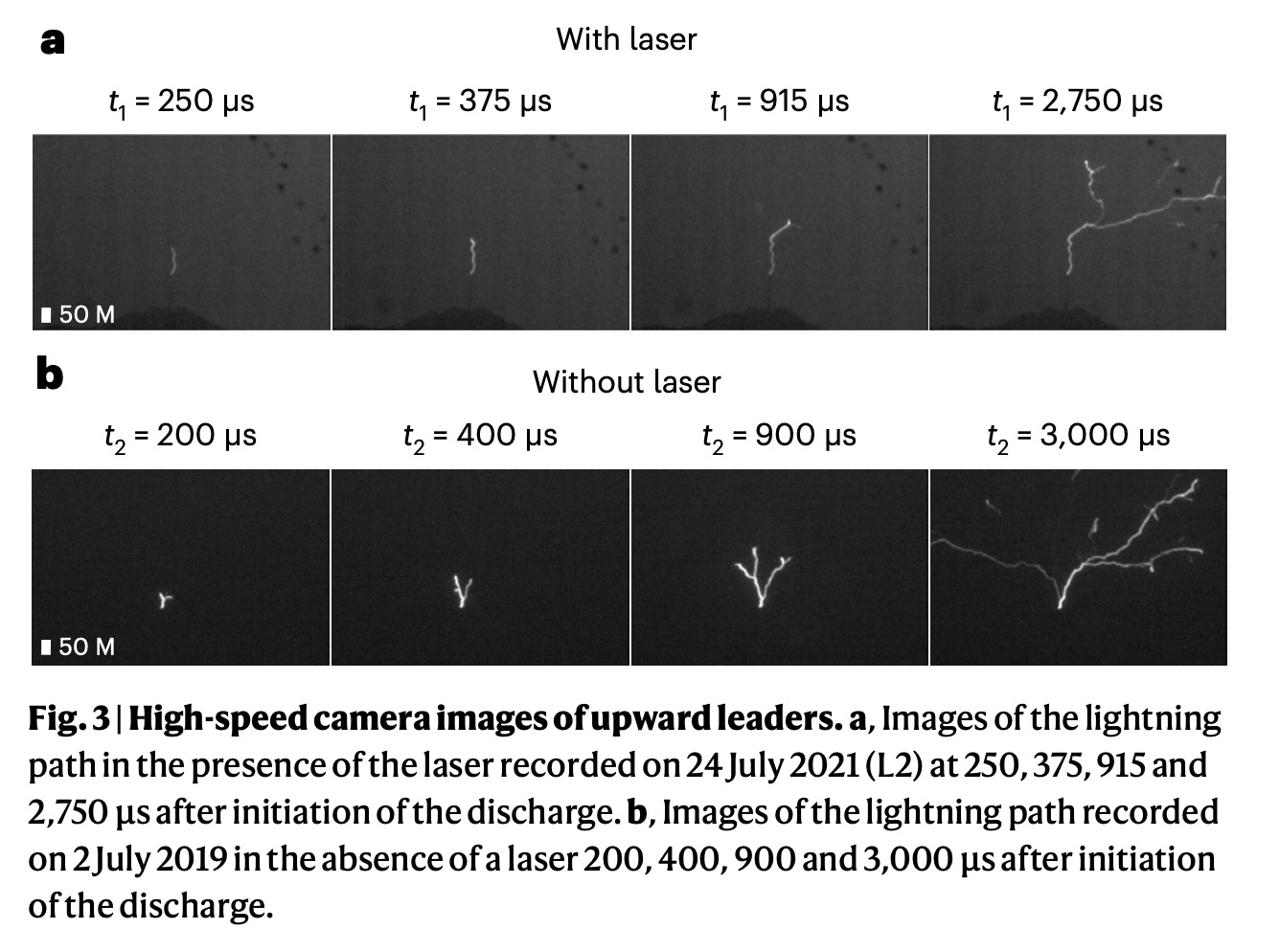

Lightning over the Spanish Pyrenees. Visual China Data Map
Lightning strikes caused by lightning kill many people every year and bring huge economic losses, but at the same time, it also silently "charges" the atmospheric ionosphere.
However, how should human beings update lightning protection technology to avoid more tragedies and uncover more lightning secrets?
In the early morning of January 17, 2023, a research paper published online in the international academic journal "Nature Photonics" reported that in a field experiment, lightning followed the laser "walking" more than 50 meters.
Prior to this, the idea of using intense laser pulses to guide lightning strikes had been studied in a laboratory setting and even patented, and the patent had expired, but had not been successfully tested in the field.
This is the first field experiment to demonstrate that lasers can deflect lightning. The experiment will take place in 2021.

Two lightning paths captured by high-speed cameras.
The title of the paper is "Laser-guided lightning."
Jean-Pierre Wolf, a professor at the University of Geneva in Switzerland, and Aurélien Houard, a researcher at the Ecole Polytechnique in France, are the co-corresponding authors of the paper. Among them, Aurélien Houard is also the first author of the paper.
On the 16th, Aurelian told The Paper via email that more data needs to be collected to more accurately quantify the role of lasers in guiding and triggering lightning.
In 2021, researchers recorded 16 lightning strikes over a two-month period, four of which were recorded with the laser turned on, Aurelian said. In one recording on July 24, 2021, the sky was clear enough, but lightning was still imaged. It can be clearly observed from the images that the lightning was guided by the laser for more than 50 meters. In the observation records of the other 3 times when the laser was turned on, through the radio frequency detector, it can also be seen that the lightning followed the laser.

In an experiment on July 24, 2021, the lightning followed the laser and "walked" more than 50 meters.
Using a high-power laser aimed at the sky, they successfully deflected lightning, an advancement that could revolutionize lightning protection, Aurelian said. Lightning is a natural phenomenon that needs to occur periodically to neutralize the electrical charge in the atmosphere. Lightning strikes kill more than 4,000 people and cost billions of dollars each year.
By far the most common lightning protection device is the Franklin lightning rod. This is a metal pole that safely directs lightning discharges into the ground, thereby protecting buildings from lightning strikes.
But beams of laser beams shooting into the sky could serve as a virtual, movable "lightning rod" as a supplement or alternative.
In order to better carry out practical applications, Aurelian believes that it is necessary to improve the triggering effect of laser on lightning. For example, use higher pulse energies or green lasers to increase the length and conductivity of the laser filament.
Aurelian introduced to Pagoda that his team and the team of Professor Jean-Pierre Wolf from the University of Geneva have been researching the use of laser wires to control discharge for 20 years. All previous attempts to channel natural lightning have been unsuccessful. But with TRUMPF developing a new laser system capable of firing 1,000 shots per second, they decided to start the European project with six other partners focused on the physics of lightning, laser filamentation , laser development and lightning protection and other research fields.
Compared with attempts in New Mexico in 2004 and Singapore in 2011, Aurelian believes their new laser has a higher peak power and can fire 1,000 times per second. Another important difference in the experiment was that they chose a site where many lightning events occur - the Santis in northeastern Switzerland. There are towering telecommunication towers there.
Aurelian said in an email that the experimental conditions on the mountain were difficult. It took several months to install the experimental facility, where the lasers were broken into small pieces and reassembled on top of the mountain. The large bracket of the astronomical telescope needs a helicopter to be transported to the mountain. The research team then had to contend with storms, with heavy rainfall falling on the experimental optics.
A large car-sized laser is mounted near a telecommunications tower. During the thunderstorm activity, the laser was operated for more than six hours, and the researchers observed that the laser diverted four upward lightning discharges. They also confirmed their observations by locating lightning strikes based on high-frequency electromagnetic waves generated by lightning.
The newly published paper says their findings expand understanding of laser physics in the atmosphere and may help develop new lightning protection strategies.
Paper link: https://www.nature.com/articles/s41566-022-01139-z
